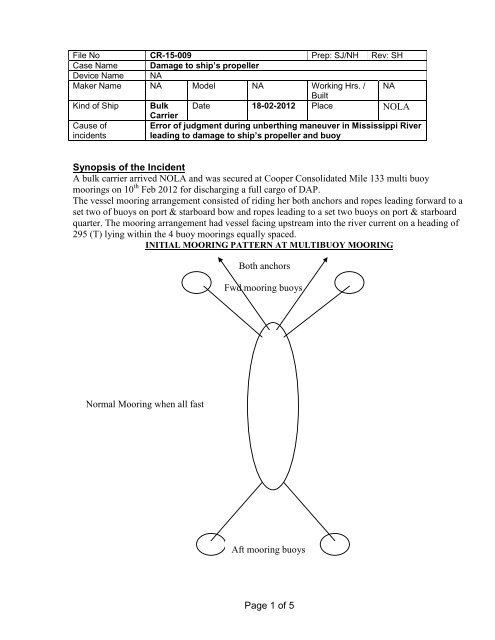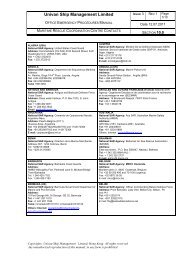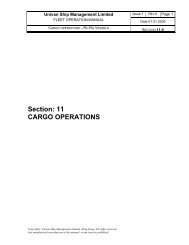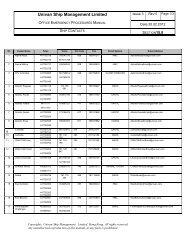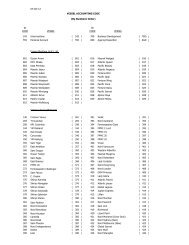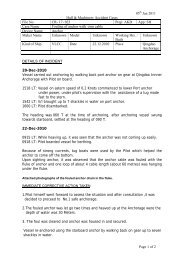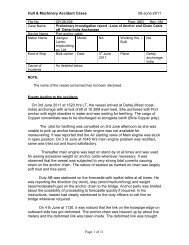You also want an ePaper? Increase the reach of your titles
YUMPU automatically turns print PDFs into web optimized ePapers that Google loves.
File No CR-15-009 Prep: SJ/NH Rev: SH<br />
Case Name <strong>Damage</strong> <strong>to</strong> ship’s <strong>propeller</strong><br />
Device Name NA<br />
Maker Name NA Model NA Working Hrs. /<br />
Built<br />
NA<br />
Kind of Ship Bulk Date 18-02-2012 Place NOLA<br />
Cause of<br />
incidents<br />
Carrier<br />
Error of judgment during unberthing maneuver in Mississippi River<br />
leading <strong>to</strong> damage <strong>to</strong> ship’s <strong>propeller</strong> and buoy<br />
Synopsis of the Incident<br />
A bulk carrier arrived NOLA and was secured at Cooper Consolidated Mile 133 multi buoy<br />
moorings on 10 th Feb 2012 for discharging a full cargo of DAP.<br />
The vessel mooring arrangement consisted of riding her both anchors and ropes leading forward <strong>to</strong> a<br />
set two of buoys on port & starboard bow and ropes leading <strong>to</strong> a set two buoys on port & starboard<br />
quarter. The mooring arrangement had vessel facing upstream in<strong>to</strong> the river current on a heading of<br />
295 (T) lying within the 4 buoy moorings equally spaced.<br />
INITIAL MOORING PATTERN AT MULTIBUOY MOORING<br />
Normal Mooring when all fast<br />
Both anchors<br />
Fwd mooring buoys<br />
Aft mooring buoys<br />
Page 1 of 5
On completion of discharging operations on 17 th night, the vessel prepared for sailing on 18 th Feb<br />
early morning. However in the final stage of unmooring on 18 th early morning, it was noticed that a<br />
wire rope was entangled in the starboard anchor. As it was not possible <strong>to</strong> disentangle the wire by<br />
manual means and required shore assistance. It was decided <strong>to</strong> re-moor the vessel.<br />
Port Anchor<br />
3 Shackles<br />
on deck.<br />
Current<br />
E x 2.9 Kts<br />
RE-MOORING PATTERN<br />
Fwd mooring buoys<br />
Modified temporary mooring arrangement while<br />
clearing fouled anchor.<br />
Aft mooring buoys<br />
This re-mooring consisted of ropes leading <strong>to</strong> set of two buoys on starboard bow. Another set of two<br />
ropes was passed <strong>to</strong> two buoys on starboard quarter. The port anchor was heaved up <strong>to</strong> 3 shackles so<br />
as <strong>to</strong> pull the vessel’s bow out of multi buoy mooring (4 buoys) <strong>to</strong>wards the port side. The starboard<br />
anchor was hanging with the fouled wire rope. The ships heading on completion of re-mooring was<br />
290 (T).<br />
Page 2 of 5
Later on 18 th Feb morning the starboard anchor was cleared and vessel was prepared <strong>to</strong> unmoor and<br />
sail outwards. Main Engines were tried out and order for SBE given at 0936 hours.<br />
Prior Unmooring two tugs “Mississippi (60 T Bollard Pull)” and “Providence (40 T Bollard pull)”<br />
were made fast on port bow and port quarter respectively. Vessel let go and pick up her stern ropes<br />
which were both leading on starboard quarter. On letting go the stern ropes the ships heading was<br />
observed <strong>to</strong> be 260 (T) as the ships had swing <strong>to</strong> port slightly.<br />
After this the head lines which were leading <strong>to</strong> starboard bow were let go and picked up.<br />
After this vessel proceeded <strong>to</strong> pick up her port anchor. As per ships deck log book port anchor was<br />
aweigh at 1012 hours LT.<br />
Following are the ME movements given and recorded in telegraph logger)<br />
TIMING HOURS MINS SEC ORDER/ACKNOWLEDGED BY ME<br />
(UTC=SMT+6)<br />
16.11.41 D S AHD<br />
16.14.52 S AHD<br />
16.15.18 H.AHD<br />
16.15.43 F.AHD<br />
16.16.32 0 RPM (RPM has dropped from 55 RPM <strong>to</strong> Zero)<br />
Thereafter, Master put his Engine Order telegraph <strong>to</strong> “S<strong>to</strong>p” realizing that ME RPM has either<br />
dropped <strong>to</strong> Zero due <strong>to</strong> hitting some obstruction or ME is not responding. Master then <strong>to</strong>ok up the<br />
ME RPM in stages <strong>to</strong> Full Ahead.<br />
At 1030 hours LT Cooper Consolidated reported <strong>to</strong> the vessel that a port aft midstream buoy was<br />
adrift as its chain had apparently been struck by the ships <strong>propeller</strong> whilst carrying out unberthing<br />
maneuver. As per Cooper Consolidated the Pilot acknowledged the contact with buoy.<br />
Following facts need <strong>to</strong> be borne in mind-<br />
Sailing draft- F-4.00/A-6.45 meters.<br />
Propeller Immersion- About 5.70 meters.<br />
Diameter of the <strong>propeller</strong>- 5.45 meters.<br />
Propeller shaft diameter-900 mm.<br />
Weight of the <strong>propeller</strong>- 11 MT.<br />
Rated <strong>to</strong>rque of propleller-14 MT.<br />
Cause Analysis:<br />
On re-mooring the ship was lying outside the 4 buoy mooring pattern. Both head ropes were leading<br />
<strong>to</strong> starboard bow and both stern ropes were leading <strong>to</strong> starboard quarter. The weight was on port<br />
anchor which had 3 shackles in water. Therefore though the ropes leading aft were showing a paid<br />
out length of 70 & 40 Starboard and port aft rope respectively) meters the actual horizontal clearance<br />
of ship from buoys was much less as the lead of ropes was at an obtuse angle as ship was not<br />
squarely placed within the buoy pattern.<br />
At this position ships heading was 290 (T) as per ship’s records.<br />
Once the stern lines followed by head lines were let go the ship turned <strong>to</strong> port <strong>to</strong> face the stream and<br />
ride the port anchor. This turn <strong>to</strong> port and tightening of the port chain brought the ships stern closer<br />
<strong>to</strong> port aft buoy. The ship’s log shows port anchor aweigh time as 1012 LT (1612 UTC).<br />
Page 3 of 5
The Engine Order Recorder shows that from 16.11.41 UTC (10.11.41 LT) <strong>to</strong> 16.15.43 UTC<br />
(10.15.43 LT) –that is within 3 minutes and 2 seconds, ME orders being ramped up from S<strong>to</strong>p <strong>to</strong><br />
Full ahead showing the urgency with which pilot reacted <strong>to</strong> the situation.<br />
As soon as anchor was weighed, the vessel needed <strong>to</strong> overcome the force of river stream and then<br />
move ahead <strong>to</strong> clear the buoys abaft. The strength of the stream in this location was 2.9 Kts, this will<br />
make the vessel fall back by 1.45 cables in 3 minutes.<br />
The forward tug was used by the pilot <strong>to</strong> pull at 45 deg angle <strong>to</strong> prevent the vessel from falling back.<br />
However, the aft tug was kept only stand by.<br />
The sudden drop of RPM at 16.16.32 UTC (10.16.32 LT) is the time of impact of <strong>propeller</strong> with<br />
buoy chain and corresponds <strong>to</strong> position of ship after picking up anchor. As per calculations based on<br />
the point from which the chain has been cut and vessels draft with relation <strong>to</strong> angle of chain at 2.9<br />
Kts current it is calculated that the bouy was 2 M from the stern when the <strong>propeller</strong> hit the chain.<br />
Fwd Tug<br />
Port Anchor<br />
3 Shackles<br />
on deck.<br />
Current<br />
E x 2.9 Kts<br />
Aft Tug<br />
Fwd mooring buoys<br />
Position of vessel upon cast off<br />
Aft mooring buoys<br />
Page 4 of 5
ROOT CAUSE OF THE ACCIDENT<br />
1. Failure <strong>to</strong> report the <strong>propeller</strong> clearance from the aft station.<br />
2. Failure <strong>to</strong> effectively utilize the aft tug.<br />
3. Failure <strong>to</strong> appreciate the strength of river current and failure <strong>to</strong> give robust ME movements during<br />
picking up anchor and immediately thereafter.<br />
LESSONS LEARNED / PROPOSED COUNTER MEASURES<br />
1) Pilot actions <strong>to</strong> be moni<strong>to</strong>red and challenged if necessary.<br />
2) Handling ships in open waters is very different from handling ships in river/near berth. The<br />
catenary of the buoy chain can be different from direct leads.<br />
3) No claims can be enforced for pilot error unless willful negligence can be proved. Master is<br />
<strong>to</strong> exercise his authority for safety of the vessel.<br />
4) Continuous moni<strong>to</strong>ring of all obstructions <strong>to</strong> be done and reported <strong>to</strong> wheelhouse till vessel is<br />
clear.<br />
Corrective Action<br />
1. Ship under water inspection arranged at next port of call, Tampa.<br />
2. Repair of <strong>propeller</strong> as per Class recommendations.<br />
3. <strong>Damage</strong> <strong>to</strong> buoy and loss of buoy cable and anchor case referred <strong>to</strong> P&I, claims expected in<br />
range of USD 230,000/.<br />
Preventive Measures<br />
1. Advanced ship handling training for Master <strong>to</strong> be arranged.<br />
2. All vessels <strong>to</strong> discuss this incident in next safety meeting and highlight the importance of<br />
clear communication during mooring stations.<br />
Gouge on Leading Edge of Blade A Near Tip<br />
Page 5 of 5


